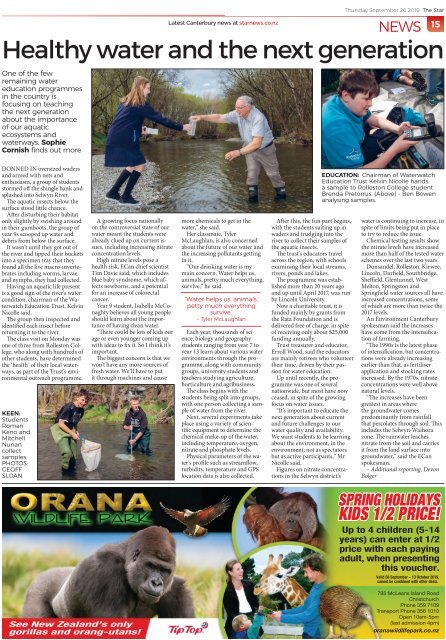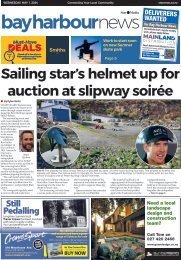The Star: September 26, 2019
Create successful ePaper yourself
Turn your PDF publications into a flip-book with our unique Google optimized e-Paper software.
Latest Canterbury news at starnews.co.nz<br />
Thursday <strong>September</strong> <strong>26</strong> <strong>2019</strong> <strong>The</strong> <strong>Star</strong><br />
NEWS 15<br />
Healthy water and the next generation<br />
One of the few<br />
remaining water<br />
education programmes<br />
in the country is<br />
focusing on teaching<br />
the next generation<br />
about the importance<br />
of our aquatic<br />
ecosystems and<br />
waterways. Sophie<br />
Cornish finds out more<br />
DONNED IN oversized waders<br />
and armed with nets and<br />
enthusiasm, a group of students<br />
stormed off the shingle bank and<br />
splashed into Selwyn River.<br />
<strong>The</strong> aquatic insects below the<br />
surface stood little chance.<br />
After disturbing their habitat<br />
only slightly by swishing around<br />
in their gumboots, the group of<br />
year 9s scooped up water and<br />
debris from below the surface.<br />
It wasn’t until they got out of<br />
the river and tipped their buckets<br />
into a specimen tray that they<br />
found all the live macro-invertebrates<br />
including worms, larvae<br />
and nymphs, they had collected.<br />
Having an aquatic life present<br />
is a good sign of the river’s water<br />
condition, chairman of the Waterwatch<br />
Education Trust, Kelvin<br />
Nicolle said.<br />
<strong>The</strong> group then inspected and<br />
identified each insect before<br />
returning it to the river.<br />
<strong>The</strong> class visit on Monday was<br />
one of three from Rolleston College,<br />
who along with hundreds of<br />
other students, have determined<br />
the ‘health’ of their local waterways,<br />
as part of the Trust’s environmental<br />
outreach programme.<br />
KEEN:<br />
Students<br />
Roman<br />
Keno and<br />
Mitchell<br />
Nunan<br />
collect<br />
samples.<br />
PHOTOS:<br />
GEOFF<br />
SLOAN<br />
A growing focus nationally<br />
on the controversial state of our<br />
water meant the students were<br />
already clued up on current issues,<br />
including increasing nitrate<br />
concentration levels.<br />
High nitrate levels pose a<br />
health risk, ECan chief scientist<br />
Tim Davie said, which includes<br />
blue baby syndrome, which affects<br />
newborns, and a potential<br />
for an increase of colorectal<br />
cancer.<br />
Year 9 student, Isabella McConaghty<br />
believes all young people<br />
should learn about the importance<br />
of having clean water.<br />
“<strong>The</strong>re could be lots of kids our<br />
age or even younger coming up<br />
with ideas to fix it. So I think it’s<br />
important.<br />
<strong>The</strong> biggest concern is that we<br />
won’t have any more sources of<br />
fresh water. We’ll have to put<br />
it through machines and cause<br />
more chemicals to get in the<br />
water,” she said.<br />
Her classmate, Tyler<br />
McLaughlan, is also concerned<br />
about the future of our water and<br />
the increasing pollutants getting<br />
in it.<br />
“Our drinking water is my<br />
main concern. Water helps us,<br />
animals, pretty much everything,<br />
survive,” he said.<br />
‘Water helps us, animals,<br />
petty much everything<br />
survive.’<br />
– Tyler McLaughlan<br />
Each year, thousands of science,<br />
biology and geography<br />
students ranging from year 7 to<br />
year 13 learn about various water<br />
environments through the programme,<br />
along with community<br />
groups, university students and<br />
teachers studying agriculture,<br />
horticulture and agribusiness.<br />
<strong>The</strong> class begins with the<br />
students being split into groups,<br />
with one person collecting a sample<br />
of water from the river.<br />
Next, several experiments take<br />
place using a variety of scientific<br />
equipment to determine the<br />
chemical make-up of the water,<br />
including temperature, oxygen,<br />
nitrate and phosphate levels.<br />
Physical parameters of the water’s<br />
profile such as streamflow,<br />
turbidity, temperature and GPS<br />
location data is also collected.<br />
After this, the fun part begins,<br />
with the students suiting up in<br />
waders and trudging into the<br />
river to collect their samples of<br />
the aquatic insects.<br />
<strong>The</strong> trust’s educators travel<br />
across the region, with schools<br />
examining their local streams,<br />
rivers, ponds and lakes.<br />
<strong>The</strong> programme was established<br />
more than 20 years ago<br />
and up until April 2017, was run<br />
by Lincoln University.<br />
Now a charitable trust, it is<br />
funded mainly by grants from<br />
the Rata Foundation and is<br />
delivered free of charge, in spite<br />
of receiving only about $25,000<br />
funding annually.<br />
Trust treasurer and educator,<br />
Erroll Wood, said the educators<br />
are mainly retirees who volunteer<br />
their time, driven by their passion<br />
for water education.<br />
Up until recently, the programme<br />
was one of several<br />
nationwide, but most have now<br />
ceased, in spite of the growing<br />
focus on water issues.<br />
“It’s important to educate the<br />
next generation about current<br />
and future challenges to our<br />
water quality and availability.<br />
We want students to be learning<br />
about the environment, in the<br />
environment; not as spectators<br />
but as active participants,” Mr<br />
Nicolle said.<br />
Figures on nitrate concentrations<br />
in the Selwyn district’s<br />
EDUCATION: Chairman of Waterwatch<br />
Education Trust Kelvin Nicolle hands<br />
a sample to Rolleston College student<br />
Brenda Pretorrus. (Above) – Ben Bowen<br />
analysing samples.<br />
water is continuing to increase, in<br />
spite of limits being put in place<br />
to try to reduce the issue.<br />
Chemical testing results show<br />
the nitrate levels have increased<br />
more than half of the tested water<br />
schemes over the last two years.<br />
Dunsandel, Rolleston, Kirwee,<br />
Lincoln, Darfield, Southbridge,<br />
Sheffield, Glentunnel, West<br />
Melton, Springston and<br />
Springfield water sources all have<br />
increased concentrations, some<br />
of which are more than twice the<br />
2017 levels.<br />
An Environment Canterbury<br />
spokesman said the increases<br />
have come from the intensification<br />
of farming.<br />
“<strong>The</strong> 1990s is the latest phase<br />
of intensification, but concentrations<br />
were already increasing<br />
earlier than that, as fertiliser<br />
application and stocking rates<br />
increased. By the 1970s, nitrate<br />
concentrations were well above<br />
natural levels.<br />
“<strong>The</strong> increases have been<br />
greatest in areas where<br />
the groundwater comes<br />
predominantly from rainfall<br />
that percolates through soil. This<br />
includes the Selwyn-Waihora<br />
zone. <strong>The</strong> rainwater leaches<br />
nitrate from the soil and carries<br />
it from the land surface into<br />
groundwater,” said the ECan<br />
spokesman.<br />
– Additional reporting, Devon<br />
Bolger


















